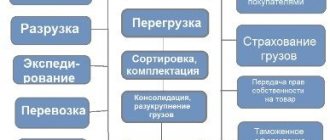Forfaiting: what is it in simple words, diagram, calculation example
| Parameter | Factoring | Forfaiting |
| For what operations is it used? | Intratrade | Foreign trade (export-import) |
| Transaction currencies | Limited number of currencies (mainly rubles, US dollars, euros) | Depends on the lender, many world currencies are used |
| Financing term | 90-180 days | Up to 1 year and above |
| Regression | Depending on the type of contract concluded | Absent, all risks are borne by the forfaiter bank |
| Amount of debt to be redeemed | Up to 90% | The debt is repaid in full |
| Additional guarantees | No | Third party guarantees are possible |
| Parties to the agreement | Bank or factoring company, seller, buyer | Bank, seller |
| Possibility of resale requirement | No | Eat |
The level of overpayment for a factoring transaction is most often higher than for a forfeiting transaction due to additional risks of the creditor bank (lack of recourse, political factor, etc.).
Description of forfaiting in simple words
Simply put, the forfaiter company takes on the risks associated with non-payment of the delivered (sold) goods by purchasing the debt and at the same time paying the seller the full value of the existing debt. In this case, the forfaiter receives from the supplier the remuneration specified in the contract.
Forfaiting is a form of lending, as are factoring, leasing and other financial instruments.
However, forfeiting is most often used in foreign economic transactions.
Calculation scheme
Financing of a forfeiting transaction can be carried out either at one time or in stages.
For example, the transaction amount is $500,000. The buyer issues two bills for $250,000, one of which is issued at a discount of 4%. According to the terms of the agreement, the transfer of the first bill of exchange to the forfaiter occurs immediately after the exporter provides a package of documents. The forfaiter then pays the exporter the first part: the cost of the bill minus the discount and commission. The second part is paid after the transaction is closed, i.e. after full payment of the goods by the importer.
Participants
The participants in the forfeiting transaction are:
- forfaiter - an intermediary company that buys receivables and takes on the risks of returning the unpaid cost of the goods;
- creditor (seller, exporter) - a person who sells (supplies) goods, who transfers receivables to the forfaiter in the form of debt securities and receives the full cost of payment for the sold goods minus the cost of the forfaiter's services;
- debtor (buyer, importer) - a person who accepts goods, who takes a loan in the form of debt securities and transfers them to the seller as an obligation to pay for the goods.
Possible risks of the forfeiting procedure
Forfaiting transactions involve the following risks, which can be classified from the point of view of the transaction participant:
- The key risk for the exporter is foreign exchange, which arises due to the fact that the value of the bill of exchange may be expressed in a different currency and there may be unfavorable fluctuations in exchange rates. Some suppliers insure themselves by including a clause in the contract regarding the possibility of price changes due to currency dynamics.
- The importer's risks in the transaction are minimal and the main one is currency risk, which is often hedged with futures contracts.
- The forfaiter bears the greatest risks. These include: foreign exchange risks, risks of untimely repayment of bills, guarantor risks, sovereign risks, importer and exporter risks.
To minimize them, the intermediary uses forward foreign exchange contracts, sets limits on the guarantor, insures the operation, and carries out a detailed analysis of the importer and exporter.
Sometimes, to reduce their risks, a guarantor is involved in a forfeiting transaction. If necessary, he may demand that the importer fulfill the payment or he himself will be obliged to fulfill the obligation for him.
Forfeiting scheme
The standard forfaiting scheme looks like this:
- The seller and the forfeiter company agree on the cost and terms of the future contract.
- The exporter and importer enter into a contract for the supply of goods.
- The seller and the forfaiter sign a contract for the transfer of debt obligations.
- The seller delivers the goods.
- The exporter provides the forfaiter with supporting documents confirming the delivery of the goods.
- The forfaiter makes payment according to the transferred documents minus the amount of the discount or remuneration.
After the final stage, the forfaiter becomes a full-fledged holder of securities confirming the need for payment by the buyer for the delivered goods. The forfaiter assumes all risks, releasing the exporter from claims for further payment.
In addition to the main contract, in which the parties are all participants in forfaiting - seller, buyer, forfaiter, the necessary documents confirming the fact of transfer of receivables are the already mentioned securities and a guarantee.
The most commonly used securities are in the form of bills of exchange and letters of credit. The bill of exchange must bear a confirmation endorsement addressed to the forfaiter. The bills, in turn, must be guaranteed or avalized by the buyer's bank, which acts as a guarantor.
A letter of credit is also issued by the buyer's bank as an instruction to the seller's bank.
The important criteria for an international forfaiting contract are the following factors:
- the currency of the contract must be freely convertible,
- the conditions of jurisdiction in resolving disputes and confidentiality of information are indicated under the condition of resale of debt obligations.
Scheme
For clarity, let’s look at the forfeiting mechanism using an example.
A standard forfeiting transaction looks like this :
- The Exporter (“John Deere, Inc.”) and the Importer (Khleborob LLC) agree on the terms of the Contract for the purchase and sale of equipment, machinery or equipment (10 combine harvesters and 5 cultivators): their cost (USD 3.5 million ), the procedure for payment and transfer, and other significant conditions.
- John Deere, Inc. is looking for an Agent Bank (Forfaiter, or a group of Forfaiters to create a consortium - to finance particularly large trade transactions). An agreement was reached with the European bank “The First International Bank” (“FIB”).
- Khleborob LLC draws up a Bill of Exchange (a series of bills of exchange - if delivery will be carried out in parts) and finds a Bank (Guarantor or Avalista) that guarantees (or avalizes) these Bills of Exchange. In our example, VTB Bank
- Sending to the bank "FIB" (Forfeiter) bills of exchange avalized by the bank "VBT".
- Supply of agricultural equipment to Khleborob LLC.
- Provision of promissory notes issued by Khleborob LLC to the supplier John Deere, Inc.
- Sale of a bill of exchange (transfer by endorsement) by the Exporter (“John Deere, Inc.”) to the Forfaiter (“FIB”).
- John Deere, Inc. receives the agreed amount from the sale of the Notes (95% of US$3.5 million).
A couple of important points: The Guarantor/Avalist must be recognized by the Forfaiter as sufficiently reliable and the terms of the Bill (and the guarantees on it) must be no less than the forfaiting period.
Typically, the value of the Note is discounted - i.e., purchased somewhat cheaper than the original price - as a payment for Forfaiter's long-term risks. The amount of the agency fee depends on the period, residence of the participants, other nuances and in practice does not exceed 1.5%.
Advantages and disadvantages
Forfaiting operations have many more advantages and disadvantages compared to other riskier instruments:
- minimal risks for the seller due to the lack of recourse, as well as full payment of the debt,
- debt can be transferred in parts,
- the buyer can set a flexible payment schedule or deferment.
The disadvantages include:
- high forfaiter discount when repurchasing debt,
- a rather labor-intensive process of collecting the necessary documents and supporting papers,
- insufficient reliability of counterparties in some countries and the lack of a clear legislative framework for the use of debt securities.
Important features of forfeiting operations
Forfaiting as a type of financing has a number of features and distinctive features:
- the parties to the transaction usually represent different countries;
- payment for the forfaiter's services in the form of commissions and interest falls on the shoulders of the exporter;
- after the bills are redeemed, the forfaiter has no right to make claims against their previous owner;
- the currency of the transaction must be freely convertible;
- the transaction between the intermediary and the seller is concluded extremely simply: by adding an endorsement to the bill of exchange;
- debt is repaid in a longer period than with factoring and leasing;
- many exporters sell only part of the securities, receiving part of the funds due to them from the importer;
- higher discount than with factoring.
Types of forfeiting
Due to the clearly established conditions for carrying out forfeiting operations, forfeiting can be divided into only two types - domestic and international.
- Domestic forfeiting is a transaction mechanism in which both parties - the seller and the buyer - are residents of the same country. In Russia, internal forfeiting is practically not used.
- International forfeiting is quite widespread throughout the world, especially in countries that export in large volumes. The parties to such a transaction are representatives of different states. In this case, the forfaiter company can be a commercial organization registered in any country.
Forfaiting in the world
This method of conducting financial activities is used in Western Europe. It is also popular in America and in almost all developed countries. A forfeiting center is now located in the capital of Great Britain; it continues to be actively developed here, providing loans to manufacturers of commercial products and trading enterprises for long periods. In addition, export lending operates in Germany.
The prospects for this method of conducting trade and financial transactions are favorable, since consortia in this area of activity are being created around the world, which may include various banking institutions.
When conducting transactions worth millions of dollars, the participation of consortia as intermediaries is the most effective, since they take on all the risks (economic, political, currency) associated with such trading operations.
The main share of trade transactions in European countries is carried out using forfeiting. This applies not only to the export market, but also to the financial market – long-term debt obligations are being realized.
Today, this method of financing is used when carrying out large transactions during the export of goods from the non-resource segment, for the supply of high-tech technical devices, machinery, and equipment. The cost of such agreements on average exceeds hundreds of thousands of dollars.
In Russian federation
In the Russian Federation, this option is not as widespread as factoring. Obstacles to the spread of financing for long-term export trade projects:
- the unstable financial situation in the country, which does not allow banks to invest money in long-term lending;
- banks and commercial organizations cannot conduct foreign exchange transactions (only from abroad) due to the law on foreign exchange regulation;
- Russian manufacturers are focused on consumers from developing countries who have a low level of financial responsibility, so it is difficult to find a bank that will agree to become a guarantor and guarantee for such transactions;
- the legislative framework of the Russian Federation is not adapted to international financial settlement schemes and does not have the ability to comply with traditions and rules of business turnover; Russian tax legislation tends to constantly change, this makes it very difficult for Russian forfaiters to miscalculate the economic effect of planned operations on the foreign market.
Currently in the Russian Federation this type of activity is used as an opportunity to confirm payment of debts to debtors not with bills of exchange, but with letters of credit. The inability to use bills of exchange during financial transactions is caused by problems related to taxes.
While this financial service operates as an individual service, entrepreneurs prefer to use factoring for payments, despite the high risks.
Comparison with factoring
Forfaiting, like factoring, is a type of financial mechanism for lending to organizations against existing receivables. However, there are quite significant differences between these two seemingly similar tools:
By timing
- for factoring – only short-term financing (no more than 6 months),
- for forfeiting – medium and long-term financing (1-10 years),
By business segment
- factoring is used for small and medium-sized businesses,
- forfaiting – for large businesses.
By risk level
- With factoring, recourse is possible, i.e. the factor's counterclaim to the supplier, as well as currency and other risks fall on the seller,
- in forfaiting – complete release of the seller from risks.
Based on the amount of debt being redeemed
- with factoring, up to 90% of the cost is paid, and the rest is paid at the time of full payment by the buyer,
- When forfeiting, the seller is paid the full cost of the goods.
For additional services
- When factoring, it is possible to provide additional services to the client - consulting, accounting, legal, etc.
- When forfeiting, no additional services are provided.
Upon assignment of debt
- When factoring, transfer of debt is impossible,
- With forfaiting, you can resell a debt obligation.
By participation of third parties
- When factoring, confirmation in the transaction is not required,
- when forfaiting, confirmation is required in the form of a security (bill, guarantee, etc.)
Forfaiting
The following types of forfaiting are distinguished:
- For financial transactions;
- For export contracts.
The intermediary, acting as a forfaiter in this agreement, is engaged in lending financial transactions between enterprises that operate in the jurisdictions of different states. Documents confirming the borrowing obligations of the importer for the exporter are bills of exchange. At the same time, forfeiting of receivables allows the use of secondary documentation, including avalis, letters of credit and other guarantees.
Mechanism and specifics
This instrument is one of the most flexible credit mechanisms for foreign trade activities. The forfeiting scheme is quite simple and has a number of stages:
- A contract is concluded between the importer and the exporter, ensuring the delivery of goods with deferred payment of money;
- A separate agreement is written between the forfaiter and the exporter, under which the exporter transfers its own economic requirements to the importer, along with a certain discount;
- The exporter ships the products on the basis of an agreement concluded between him and the buyer;
- The forfaiter receives papers confirming the shipment of the products, and then compensates the price of the shipped goods, along with commissions and discounts, in favor of the exporter.
Further, the features of forfaiting give the forfaiter the right to collect the bill of exchange from the importer in full within a strictly specified time frame, or to resell the debt to a third party. Any risks of non-payment of the bill of exchange on the part of the client are assumed by the forfaiter. If the debtor successfully pays the bill, the forfeiter's net proceeds are equal to the discount minus the costs of the procedure.
Forfaiting as a financial instrument of foreign trade
Forfaiting can be called a universal technology for foreign trade lending, which, like the economic sphere, is the main consumer of the services of financial and credit institutions. However, in reality, trade organizations may experience difficulties in obtaining a one-time loan for the purchase of imported products.
To actively develop business activities, it is necessary to purchase foreign equipment in installments. In practice, loans to an enterprise are provided for no more than 1-2 years, while the financial structure often has the right to increase the interest rate on the loan if adjustments occur in the foreign exchange markets.
In such a case, forfaiting becomes a much more financially profitable alternative to a loan. Such a mechanism for acquiring receivables involves an easy and efficient method of settlement between the supplier and the client.
Transaction participants
Although the international forfeiting agreement is concluded without any participation of the importer, in fact the agreement includes three participants:
- A creditor who supplies products, accepts debt from the debtor in the form of a guarantee of further payment, and resells these obligations to the forfaiter at a prescribed discount.
- A debtor who purchases products and provides payment guarantees to the supplier using promissory notes and other related papers.
- Forfaiter is an organization that purchases debt at a discount from a bank in order to then resell it to a third party.
The importance of such a procedure is high for both participants in the transaction, because it greatly speeds up the transaction and makes the work easier. Debt forfaiting allows the buyer to postpone the time of payment of money, and the seller receives money immediately after shipping the product. As for the forfaiter, he is expanding the geography of his own activities, collaborating with new consumers from abroad.
List of documents
To carry out the forfaiting procedure, the exporter must provide the forfaiter with certain documents:
- A copy of the agreement with the importer for the provision of products;
- A copy of the certified invoice;
- Copies of documents confirming the shipment of products;
- Transfer record for debt;
- Letter of guarantee.
In addition, if the forfaiter has doubts about the supplier’s solvency, he may require additional guarantees with documents from third parties.
Forfaiting for small businesses
The use of forfeiting as an economic mechanism for small businesses has objective limitations - small companies often operate in the market of one state and almost do not cooperate with foreign organizations. For them, factoring is more profitable.
However, small businesses in the innovation sector need increased financial flexibility, since high-tech is characterized by its indispensable interaction with business partners from more developed countries. Forfaiting is useful for such organizations as a convenient tool for mutual settlements with foreign counterparties.
Since monitoring the solvency of numerous small organizations is much more difficult than calculating the financial characteristics of large enterprises, forfaiters prefer to unite in so-called syndicates. Such entities optimize the costs of controlling the finances of individual small companies, reduce risks and provide their services to a wide range of business structures at reduced prices.
Forfaiting and factoring
The similarities and differences between forfeiting and factoring are very diverse. The main difference is that the factoring object is, in fact, an invoice for the sale of products, and the forfaiting object is a debt. Another difference is that forfeiting is most often used in foreign trade procedures, while factoring is focused on trading activities in a single legal field.
An additional condition that distinguishes factoring from forfaiting is that factoring buys out short-term debt, while forfaiting involves long-term loans for a period of 1 year or more. At the same time, in factoring additional guarantees for the buyer of the debt are not possible. The forfaiter may require more guarantees from third parties to ensure the debtor’s solvency.
It is important to understand that factoring involves 2 types of agreement - with and without recourse. In a forfaiting agreement, only a non-recourse transaction is used, in which the risk of non-fulfillment of debt obligations falls entirely on the forfaiting company. In addition, under the conditions of the factor, the volume of acquired debt does not exceed 90 percent, and forfeiting does not have such restrictions.
Finally, factoring presupposes the impossibility for such an organization to resell debt to third parties, unlike a forfaiter who is able to sell bills as he sees fit.
Advantages and disadvantages of forfeiting
Let's look at the advantages and disadvantages of forfeiting. For exporters, the main disadvantage is the inflated cost of financing compared to other loans. For the importer, the disadvantages of forfeiting are associated with side costs - commissions for a bank guarantee. If such a document is used, the consumer's access to the loan is limited. As for the intermediary, in forfaiting he has no recourse, which does not give the forfaiter the opportunity to repay the debt if the debtor does not pay it.
However, the advantages of such a mechanism are much greater:
- Through forfeiting, the seller can more effectively control the risks of foreign economic procedures. That is, for the exporter, the forfeiter is an insurer that guarantees payments for the secured products.
- The sale of receivables can be carried out in shares. If necessary, the exporter sells the debt, making his business more economically flexible.
- By reselling the debt to the forfaiter, the exporter speeds up the receipt of money after shipment of the products. The sooner he receives his funds, the sooner he will be able to put them into circulation and receive additional income that covers the costs of paying the forfeiting discount.
Results
With the help of forfeiting, the product supplier completely avoids economic risks in the event of client insolvency. Such a mechanism allows you to divide the debt into separate shares, achieving an advantageous balance between the money required immediately and the funds that may arrive later, when the bill is paid.
For the consumer, forfeiting guarantees an improved payment schedule for obligations, which implies more frequent use of the instrument in foreign trade activities by various organizations.
The emergence and spread of forfeiting was the result of the increased growth of foreign expensive products with a long production period. Since there is strong competition in the international market, and the role of lending is increasing, forfaiting has become a significant tool, the development of which is actively pursued by various forms of entrepreneurial activity, regardless of their scale.
Required documents
Any form of forfeiting requires the presence of a certain package of documents. There are not many of them, but nevertheless they are the basis of forfaiting relationships.
- A copy of the contract for the supply of products or provision of services;
- A copy of the invoice, certified by the signatures of the exporter and importer (this is similar to an invoice);
- A copy of transport documents (documents confirming the dispatch of goods);
- A transfer note on the bill of exchange indicating that it is being transferred to the forfaiter;
- Letter of guarantee, guarantee on a bill or aval.
Parties to the agreement
Forfaiting involves three parties. But it is worth remembering that the contract is concluded between two parties (exporter and forfaiter).
- Seller (exporter or lender) . He is most often the manufacturer of the product, who sells it himself. The exporter, after the buyer has issued bills of exchange on him, has two options. Either wait a certain time until the importer pays him the required amount, or sell the receivables to a forfeiting company. If the seller chooses the first option, he receives the entire amount in full, but after some time. In the second option, the exporter loses a few percent (commission or discount), but receives money immediately.
Many entrepreneurs sell only part of the securities, after which the buyer pays the rest of the amount directly to the seller, and part to the forfaiter.
A discount is a kind of fee for the services (purchase of bills) of a forfeiting company.
- Buyer (importer or debtor) . He does not make a cash payment, but writes a written commitment stating that he undertakes to pay the debt. Such receivables can be represented by bills, avals, certificates, etc. With forfaiting, only the debt repayment scheme changes for the buyer; he transfers money not to the exporter, but to the account of the forfaiting company.
- Forfaiting company . After concluding the contract, transfers the required amount upon shipment of the goods by the seller.
Thanks to forfeiting, many companies find foreign clients. In addition, their production and sales geography are expanding.
When is factoring beneficial for suppliers and when is forfeiting
Worsens the financial stability of the enterprise. Working resources are being reduced. This happens in the example of energy enterprises, gas supply and oil pumping industries. They have a cash gap at the time they receive the money supply from a completed internal transaction within the borders of one state. There is also a cash gap from the export and import transaction in the form of factoring. The supplier focuses entirely on its core business. She gives him positive business. By the nature of the activity, partnership, 4 parties take part and interact in a transaction at once. In the exchange of bills and money, their intermediaries also act and directly participate. They provide their platform for electronic tendering and bidding, as well as factoring services.
In forfaiting operations, as well as factoring, financial transactions are carried out in the form of the sale of up to 10% of the receivable. Draws up a trade transaction for the purchase and sale of bills of exchange. The procedure also covers the entire period of the financial transaction. The credit institution takes on obligations and all kinds of commercial risks. They do not include the risk of the share of recourse that remains with the supplier. This form of foreign trade cooperation is most beneficial for exporters. Factoring contracts are issued for a short period of up to 6 months. The operation of large-scale and minimal cooperation in terms of the amount and volume of the transaction during forfeiting reaches the level of medium and long-term value. Sometimes in partnerships there are contracts with a duration of 10 years.
Examples
Let us give examples of forfeiting with one-time and partial financing.
Example 1. An exporting company registered in Germany entered into a contract with a Spanish company for the supply of a batch of cars. The transaction amount is $2 million.
The buyer found a bank that agreed to become a guarantor for the transaction. Next, the Spanish company issued 2 bills of $1 million each at a 6% discount and transferred to the exporter.
In turn, the exporter entered into a contract with the forfaiter bank and all conditions were agreed upon, the key ones being the following:
- the guarantor meets the requirements of the forfaiter;
- financing occurs in 2 stages. Stage 1 – after the exporter provides documents to the bank, Stage 2 – after the importer has fully repaid the debt;
- the commission for forfeiting is 3% and is retained at the 1st stage of financing.
The exporter's expenses will be 9% of the transaction amount (6% discount and 3% forfeiter commission):
2000000x9%=$180000.
Thus, the exporter will receive an amount of $1,820,000 in two stages:
- $880,000 after submitting documents confirming the fact of delivery to the bank;
- $940,000 after the importer pays the amount owed.
Example 2. A company operating in the UK supplies equipment to Italy. The contract amount is $1 million 500 thousand. One bill of exchange was issued for this amount at a 5% discount. Forfaiter commission – 5%.
Financing of the transaction is carried out in a lump sum after submitting documents to the forfaiter. The exporter's expenses will be 10% (1500000x10%=$150000). The amount to be transferred to the exporter's account will be $1,350,000 (1,500,000-150,000).
What is forfeiting
Today, quite a lot of new financial transactions have appeared, which in fact have certain innovative characteristics and features. Forfaiting is an action that determines that a financial agent, which most often is a bank, on certain (naturally favorable) terms, acquires the obligations of the borrower in a debt format that are owed to the lender. The key characteristic of these processes is that, most often, lending to certain companies is provoked in this way when conducting foreign trade operations. That is, we are talking about those transactions that are concluded on global markets (transactions between foreign partners are taken into account).
You can often come across the term international forfeiting, which is used in a specific form for European business. It should also be said that there is another important nuance, which determines that all risks under clearly defined debt obligations are transferred to the forfaiter bank, and there is no possibility of returning these risks to the seller of the obligations.
Forfaiting operations can be divided into two main types:
- Financial option. A tool that is used if it is necessary to carry out the process of quickly closing a contract. In other words, this option is used if the transaction requires the fastest possible implementation of long-term obligations;
- Export option. A means that determines the possibility of transferring a clearly defined amount of funds to an exporter who has provided a kind of loan to a foreign buyer on the basis of a standard agreement.
As for the forfaiting mechanism itself, we need to consider it more clearly so that everything becomes more obvious and understandable. The essence of the operation is that the forfaiter agent carries out the process of purchasing from the seller various financial obligations of the buyer (importer). Most often, the forfaiter is the bank, which itself preliminarily, partially or completely carries out the process of paying the cost of the consignment of goods that has already been delivered to the buyer.
And subsequently, the buyer-importer transfers to the bank the clearly paid amount, as well as the remuneration. Most often, the amount of this reward will not be more than two percent. Accordingly, it becomes clear that at the moment such a process is beneficial for many entrepreneurs. There are certain differences from a loan. A simpler method of design is provoked. But in our country the service is relatively young. Therefore, many entrepreneurs are quite wary of it.
Forfaiting is a type of trade format financing. The main element of such a transaction is the purchase by the bank of its client’s receivables. In this case, the debt can be represented by avals, bills, certificates, and other obligations that have arisen with the client. As you already understand, most often it is the manufacturer-exporter who acts as the seller, and the buyer is often a foreign wholesaler. The transaction is completed by paying the seller the amount of funds in accordance with the terms of the previously signed agreement between the seller and the buyer. The amount is paid by the bank instead of the buyer. The borrower becomes the buyer who, within a specified period of time, must pay the bank certain commission payments, interest on the use of bank funds, and the principal amount.
The repayment scheme for the buyer assumes that he will fulfill his long-term obligations to the seller at the expense of the bank. Forfaiting of receivables is considered very common. On the other hand, this option is not always beneficial for the parties, therefore, not in every transaction the parties resort to the services of a bank that would act as forfaiting.
Through such an operation, the seller can immediately receive funds for the goods sold, and in the shortest possible time. Everyone knows that long-term deals with payment in installments over a fairly significant amount of time are used by many sellers. To increase competitiveness, providing such services is simply necessary. However, in this situation, the funds are frozen; they cannot be put into circulation until the buyer fully repays his obligations. Having received funds immediately after the transaction, the seller has the opportunity to invest funds in his development. Therefore, forfaiting is quite profitable for the seller.
As for the buyer, such actions provide him with the opportunity to make the desired purchase without the need to immediately invest cash. At the same time, we are talking about a kind of credit transaction, which at the same time does not require collateral. And the most important thing in all this is that forfeiting transactions are confidential, and accordingly, these obligations will not affect the company’s reputation. All costs related to debt management are borne by the bank or financial institution. Currency risks will also be minimized, since the established rate payments are established immediately after the transaction. And changes in the exchange rate will not make them more significant.











